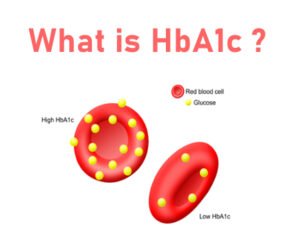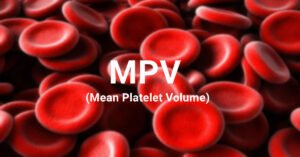The red cell distribution width test is abbreviated as RDW. It is a simple and inexpensive parameter traditionally used in hematology labs for the differential diagnosis of anemia. It is a part of the standard complete blood count (CBC) test.
Mean corpuscular volume (MCV), mean corpuscular hemoglobin (MCH), and mean corpuscular hemoglobin concentration (MCHC) are called red cell indices. These values help diagnose many conditions, including anemias. Electronic cell counters are available to measure these red cell indices automatically. In some medical conditions, the size of red cells varies. This variation is quantified and expressed as red cell distribution width (RDW).
Introduction
Red blood cells (RBC) are the most common type of blood cell. With the help of Red blood cells (RBC), oxygen is transported through the circulatory system from the lungs to the peripheral parts of the body. These are equal in size and shape. However, in some diseases, RBCs can have abnormal shapes and smaller or larger sizes than average.
Red blood cells’ usual volume is between 80-100 femtoliters (fl), which can vary significantly under particular circumstances. This heterogeneity of the cell volume is called anisocytosis. RDW is a quantitative measure or degree of variation in red blood cell size on the peripheral blood smear. High RDW is significant, but low is infrequent and clinically meaningless.
How to calculate RDW blood test values?
Automated blood analyzers have specific channels through which red cells pass. It results in a series of histograms.
A formula calculates RDW.
The red blood cell volume’s standard deviation (SD) is divided by the mean corpuscular volume (MCV) and then multiplied by 100 to get results in percentage (%). The conventionally used reference range of RDW is roughly 12%-15%.
RDW = (standard deviation of MCV ÷ MCV) × 100
What is the red cell distribution width (RDW) blood test?
The red cell distribution width test measures the differences in the size and volume of red blood cells based on the width of the MCV histogram (i.e bell-shaped curve around the mean). It is a red cell measurement that quantitates cellular volume heterogeneity, reflecting the range of red cell sizes in a blood sample.
If there is a single uniform size of red blood cells, the value of RDW will be small it is due to the fact that all RBCs cluster tightly around the mean. And if there is a large variation in cell sizes, the broad peak will be visible on a histogram. If there are two distinct populations the RDW for both non-uniform people would be increased.
If the value of RDW varies from the normal range, it indicates some underlying pathology. RDW is a sign of many underlying medical conditions. Some of these conditions are
- Anemias (Classification mentioned inside the diagram)
- Iron and vitamin B12/folate deficiency
- Liver/Kidney diseases
- Blood disorders/bleeding
- Congenital disorders like thalassemia
Classification of disorders using RDW (CV) and MCV in anemia

Clinical uses of RDW blood tests in human diseases
Increasing and convincing evidence shows a significant association between anisocytosis and human disorders (mentioned in the following diagram).
- RDW differentiates various types of anemia. Iron deficiency anemia has high RDW, and thalassemia trait has normal RDW.
- RDW is a strong marker for all-cause mortality in the general population.
- It also predicts the adverse outcomes in cardiovascular diseases of various types.
- It indicates an increased incidence of venous thromboembolic disease.
- RDW is also a predictive and prognostic indicator for some tumors.
- RDW indicates cardiorespiratory fitness.
Cardiovascular and Thrombotic Disorders
- Cardiovascular disease
- Coronary artery ectasia
- Heart failure
- Atrial fibrillation
- Peripheral occlusive artery disease
- Acute mesenteric ischemia
- Venous thrombosis
Metabolic disorders
- Diabetes
- Kidney disease
- Liver disease
- Sub-clinical hypothyroidism
Acute conditions
- Acute poisoning
- Acute pancreatitis
- Preeclampsia
- Critically ill patients
- Trauma
- Hip fracture
Chronic conditions
- Cancer
- Inflammatory bowel disease
- Chronic obstructive pulmonary disease (COPD)
- Community-acquired pneumonia (CAP)
- Migraine
Difference between MCV and RDW
Following are the differences between MCV and RDW
| MCV | RDW |
|---|---|
| Mean corpuscular volume (MCV) is a measurement of the average size of a single red blood cell (RBC). | RDW is a calculation of various RBC sizes. |
| The normal MCV range is 80 – 100 fl. | The reference range of RDW is 12% – 15%. |
| A low level of MCV (below 80) is significant. | A low level of RDW (below the reference range) is insignificant. |
| MCV = vol of packed cells per 1000 ml of blood / red blood cell counts in millions | RDW = (standard deviation of MCV ÷ MCV) × 100. |
Conclusion
Several clinical pieces of research prove that this simple and inexpensive parameter, RDW is much more valuable. It provides an excellent overview of the general health status. It also predicts the prognosis of various disorders and the presence of subclinical and clinical diseases.
Regardless of the cause, patients with increased RDW values should be monitored and evaluated more closely.
Frequently Asked Questions
Q1. What is the normal range of RDW-CVin blood tests?
The results of RDW are usually expressed in a percentage; its usual upper limit for a normal RDW test is 14.5% to 15.0%.
Q2. What do RDW-CV blood tests normal, high & low mean?
1. A low RDW blood test is insignificant and has no importance. No condition regularly yields an RDW less than normal. 2. Thus, in practice, the RDW is either normal or elevated. A high RDW means a large variation in red blood cell sizes.
3. High RDW levels are associated with older age, lower level of education, current smoking, higher BMI, and nutritional deficiencies.
4. An RDW in the normal range indicates that the size distribution of RBCs has a normal degree of variation and a relatively homogenous population of red cells.
5. It is insensitive to eliminate the possibility of RBC abnormalities because there may be a uniform population of abnormally small or abnormally large cells (ie, a normal RDW centered around an abnormal cell size).
Q3. What causes high RDW blood test values?
The following conditions may have high RDW values.
• Nutritional deficiencies like iron, folate, and Vit B-12 deficiency.
• Inflammation
• Blood transfusions
• Alcoholism
• Liver disorders like biliary cirrhosis, hepatic cancer, cirrhosis, and alcoholic cirrhosis.
• Bleeding or hemorrhage
• Kidney diseases
• Sleep disorders
• Tumors like liver, kidney, cancer, and gastric.
• Disorders like sickle cell anemia and thalassemia.
Q4. Which factors may affect RDW values?
• Age: Increases its value
• Erythropoietin: Low erythropoietin level increases RDW
• Gender: Not affected
• Race: Black people have higher readings.
• Exercise: Increase with strenuous exercise
• Pregnancy: Data suggested these may significantly increase between 20th and 32nd week and then decrease.
Q5. Is RDW the same as MCV?
No, these are not the same. RDW is mathematically derived from the MCV. Although its value may be significantly influenced by the average erythrocyte volume (i.e., the MCV).
References
- Salvagno, Gian & Sanchis-Gomar, Fabian & Picanza, Alessandra & Lippi, Giuseppe. (2014). Red blood cell distribution width: A simple parameter with multiple clinical applications. Critical Reviews in Clinical Laboratory Sciences. 10.3109/10408363.2014.992064.
- Lippi, Giuseppe & Plebani, Mario. (2014). Red blood cell distribution width (RDW) and human pathology. One size fits all. Clinical chemistry and laboratory medicine : CCLM / FESCC. 59. 10.1515/cclm-2014-0585.
- Caporal, F. A., & Comar, S. R. (2013). Evaluation of RDW-CV, RDW-SD, and MATH-1SD for the detection of erythrocyte anisocytosis observed by optical microscopy. Jornal Brasileiro de Patologia E Medicina Laboratorial, 49, 324–331. https://doi.org/10.1590/S1676-24442013000500005






